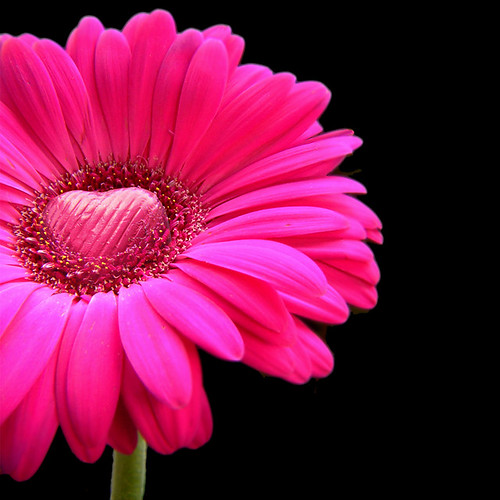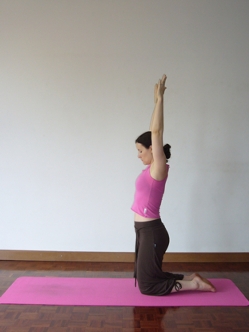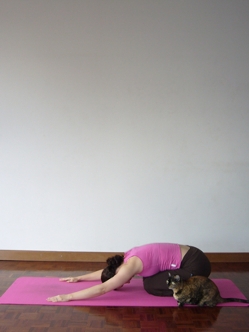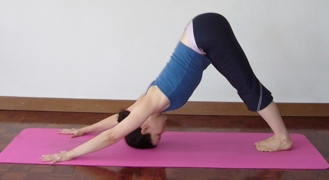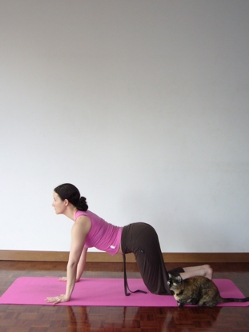It’s so ironic: I am a yoga teacher (which, lets be honest, implies a more relaxed lifestyle than usual) and I found myself with a chronic shortage of time and energy towards the end of last year. Maybe I felt left out when I heard everyone else’s complaints about working too hard/not having enough time? These days, it really is difficult to live a balanced life, since more and more seems to be expected of us, and there are still only 24 hours in a day. Yoga means union and therefore balance between ha (sun) and tha (moon). This balance needs to apply to all polar opposites – our masculine and feminine selves, upper and lower body, heaven and earth, back and front, left and right, work and play. But how do we even think about getting there?
It depends a lot on how balanced you feel – we all have a different comfort zone for how hard we can work (or play) without getting ill, or depressed, or just plain grumpy. As a rule, all of us need at least a little quiet time every day to recharge the batteries. Look at your life, and try to earmark what needs to be changed.
Go through all the main areas: work, family, studies, social, spirituality and so on. Note which areas are fine, and which are a drain. Some things can’t be changed, and some can, but there is usually a way to make your days flow more smoothly. If you are a parent, and your kids are small, the concepts of free time and sleep will be foreign to you, but it is ok to cut down in other areas like socialising. Also decide what is important to you and what isn’t; notice how much time you actually spend on the unimportant stuff (it’s almost certainly not all necessary) and see whether that can be reduced.
For example, although I absolutely love my work, one of my main issues was the amount of driving I was doing – it wasn’t unusual for me to spend four hours a day in the car. Now I don’t like driving. I give the keys to my husband every time we go anywhere together. Clearly I had to change something. It wasn’t easy, because it meant I had to give up classes with people I had grown fond of, but the situation couldn’t stay as it was, so I did what I had to do. Granted I was prompted by illness, but you could be more sensible and do something before you get sick!
If you find that your actual job is causing most of the stress – perhaps the environment is very high pressure and you really hate being there – that too can change. There is always a way, if you allow yourself a little time and space to consider the options. If you really give yourself permission to change jobs or careers, opportunities seem to appear out of nowhere.
It may just be a matter of changing how you do things – instead of driving from one end of the city to the other, try to arrange your activities so they are all in the same area on a given day. Sometimes less is more too – you don’t have to accept every invitation that comes your way. If you prefer to spend that time in a nice bubble bath, do it!
Any yoga practice helps us feel where and how we are out of balance, by bringing our awareness to the quality of our breath (which is invariably short and restricted when we are stressed) and also to the sensations in front and back, left and right. A practice that emphasises asymmetrical poses, or forward bends paired with backbends, will help this process along.
And of course, actual balancing poses are very useful! Ironically, if you try to do one-legged balancing poses with an unfocused mind, you will wobble, but they also clear the mind, so if you persist through the wobbling, you feel more balanced afterwards.
My favourite is tree pose (vrksasana).
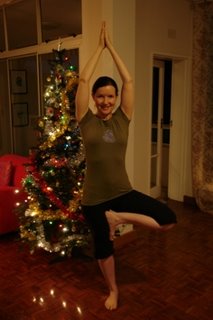 Stand with feet together, toes spread wide, and equal weight through both feet. Slowly shift the weight to your right foot, and place your left foot against your right inner thigh (or knee, or ankle, doesn’t matter). Keep the weight through the midline of your body, and if you are feeling balanced, as you inhale, raise your arms out to the sides and up, to touch palms overhead, then exhale to draw your hands to your heart in anjali mudra. (below)
Stand with feet together, toes spread wide, and equal weight through both feet. Slowly shift the weight to your right foot, and place your left foot against your right inner thigh (or knee, or ankle, doesn’t matter). Keep the weight through the midline of your body, and if you are feeling balanced, as you inhale, raise your arms out to the sides and up, to touch palms overhead, then exhale to draw your hands to your heart in anjali mudra. (below)
 Either stay for six breath without the arm movement, or repeat the arm movement six times with the breath. Then change sides. Ahhhhh, balance. (Yes, the tree in the background was deliberate!)
Either stay for six breath without the arm movement, or repeat the arm movement six times with the breath. Then change sides. Ahhhhh, balance. (Yes, the tree in the background was deliberate!)
Notice which side felt easier, and how the left side felt different to the right. If you want to warm up before practicing tree, do dynamic tadasana six times first. Stand with feet together, inhale to come up onto tiptoes and raise arms out to and up, exhale to come down. Arms and feet move in unison with breath.
You can also try a simple pranayama breathing exercise, called anuloma (with the grain) ujjayi. Sit comfortably, either on the floor or a chair, and start to breath in and out using ujjayi breath, constricting the back of the throat so it sounds a bit like you are snoring. When you are comfortable, start to breathe out through alternate nostrils, using your right hand to control the flow of air. So breath in: ujjayi, breath out: left nostril (release the sound in the throat), breathe in at the throat, breath out: right nostril, and so on. Notice the difference between sides. Do a few rounds of this then rest, breathing normally, and notice how your breath feels.
As always, please make sure you are in good health before trying these exercises and stop if you feel anything is amiss.
